This is a guest article by HiveMindEmulator, originally posted in the forum.
One of simplest basic strategies you learn which is surprisingly effective in the base set is “Smithy Big Money”. The idea of this strategy is to open Smithy/Silver, add a second Smithy sometime after a couple shuffles, and other than that, buy just money and VP cards. You can add in some card to help with the late game, like Market or Remodel, but for the most part, it’s just a couple Smithies and money. The idea is that the Smithy is going to draw you up to 7 cards, and with 7 cards, you can very often buy Gold. And when you have enough Silver/Gold, you can often buy Provinces.
When you add in some expansions with more trashing and other engine-friendly cards, as well as cards that are better than Smithy with “Big Money” strategies, Smithy BM becomes pretty weak. But there are some variants of it that you may at times go for, particularly when there is no way to quickly build a strong engine. The goal of this article is to look at the terminal draw cards and discuss the differences from plain old Smithy BM and how they affect the game.
Before we get into the cards, we should outline a few general ideas about terminal draw BM. First off, you can’t afford to have too many actions, particularly terminals, because you’re going to draw cards dead. And compared to decks without card-drawing, you go through more cards per turn. As a result, you want to stick to a couple drawing cards and only mix in other actions that do something particularly strong in the early- or late-game. Examples include end-game accelerating trash-for-benefit cards like Remodel or Salvager, and really strong estate-trashing openings like Jack of All Trades, Masquerade, or Island. With these three cards in particular, you want to open them ahead of Smithy, adding the Smithy on turn 3-4.
While you want to take it easy on the actions, you’re more than happy to grab kingdom treasure cards like Fool’s Gold, Venture, Stash, Cache, Royal Seal, Bank, Hoard, or Harem (not Loan, Contraband, Quarry, Talisman or Horn of Plenty, which are primarily for engines, and not Philosopher’s Stone, whose potion cost makes it too slow for a fast BM strat). Kingdom treasures tend to make terminal draw BM stronger, so the presence of one of these cards may steer you be more likely to play terminal draw BM. Terminal draw BM decks are really set back by drawing $5 (which is a little too much for a Silver but not enough for a Gold), so being able to buy Venture is a real benefit.
On the flip side, strong engine parts and Colonies are real drawbacks to running a terminal draw big money strategy. Your slow-but-steady “tortoise” strategy is more likely to be hammered down by a game-ending mega-turn “hare” strategy.
A couple of tactics also show up in terminal draw BM games.
- If playing your draw card will trigger a reshuffle, you have to weigh the benefits. Usually it’s worth it, since skipping this play of the card is usually just as bad as having it miss the shuffle, but if it’s not going to improve your buying power, you should skip it.
- When it comes down to Duchy dancing, you want to keep track of your oppnents key cards: their terminal drawers and their Golds. For Smithy BM, for example, once you’re well into greening, Province turns typically require Smithy+Gold or 2xGold. So if you can tell from previous turns that your opponent can’t have one of these hands, you may want to break the Penultimate Province Rule.
As a disclaimer, none of the numerical things I say in this article are to be taken too literally. When I say that you want a Smithy “after the second shuffle”, that doesn’t necessarily mean that something magical happens when you shuffle the deck a second time. It’s just a relative timing. At around 16-18 cards in your deck, you can tolerate a second Smithy if your only actions are Smithies. But if you want to add some other card, or your opponent does some sort of attack, that changes things. The point of this article is to describe relative differences between these cards, so saying you want the second Smithy after the second reshuffle does mean something relative to saying you want a second Oracle before the second reshuffle. You have to wait a little longer for a the second Smithy than for a second Oracle, in order to let your action density thin out a bit. I’m also not going to go into when you might prefer to skip terminal draw altogether in favor of other terminals. You can get a bit of that from this thread, though beware that that thread does not consider combining multiple different terminals.
So on to the cards:
Envoy
Envoy is the closest cousin of Smithy — so close that it was cut from Intrigue due to the great similarity. So what is the difference? Envoy adds 4 cards to your hand instead of 3, and draws 5. Because it draws so many more cards, you really can’t afford to add any terminal actions to your deck (i.e. no second Envoy). In the Envoy turn you see more than half your deck, so the probability of collision is higher than the probabilty of non-collision until your deck size is at least 19, at which point the game is probably already over. Although you can’t really add any other terminals to Envoy, you still get plenty of plays out of your single Envoy due to the rapid cycling. Though you want to avoid terminal actions, you should still be willing to open Jack or Island before getting your Envoy (with Masquerade, you’re better off just skipping the Envoy).
Courtyard
Courtyard is the version of Smithy that did make it into Intrigue. It’s sneaky good, because at first glance, you may tend to think of it as being closer to Moat, costing $2 and netting 2 cards. However, it serves as a beautiful example of how pricing works in dominion. More expensive does not mean better in all situations. In an engine where you play a lot of drawing cards to get a huge hand and buy multiple cards, Smithy is better because it nets more total cards. If Smithy cost $2, it would be overpowered in Village/Smithy-type engines since you would be able to get a bunch of them on extra buys, but Courtyard at $2 is just fine. In BM, on the other hand, the returning a card to the deck top is actually a benefit, not a penalty. Courtyard BM is significantly stronger than Smithy BM, but in BM, the difference between $2 and $4 is basically nothing, since you don’t have the extra buys.
So the question is how to take advantage of the ability to return a card to your deck. The most immediate benefit is that you don’t have to worry about 2 Courtyards colliding. One can just put the other back on top of the deck. This means you can, and should, buy your second Courtyard much sooner (i.e. after a single Silver), and can be much more willing to add a third (terminal) action to your deck. Having 2 Courtyards very early can be a huge advantage, since as with Smithies, when you play them, you very often find yourself able to buy Gold. Combining this with the power to put back excess money on hands where you draw to $5 or $7, and you’ll find that you are able to get a huge amount of Golds early. Once you’ve racked up the Golds, it’s smooth sailing, using your Courtyards to rearrange your hands into mostly $8s. As with Smithy, you should prefer to open Island, Jack, or Masquerade ahead of Courtyard, delaying your first Courtyard to turn 3-4. And if you open Jack or Masquerade, you also want to delay your second Courtyard, since you already have that extra terminal.
Masquerade
Even though it is a terminal draw card, Masquerade actually ends up functioning more like Jack of All Trades than like Smithy. This is because the trashing aspect is more significant than the drawing aspect, which primarily functions to help you find Estates to pass/trash and to allow you to still have buying power while trashing. +2 cards is much less likely to actually allow you to buy Gold early, but with your first couple plays of Masquerade, you’re very likely to remove a couple of Estates from your deck. With fewer Estates, even 5 card hands have a good chance of being worth $6+, and the 6-card Masquerade hands are even better. Since the primary function of the Masquerade is Estate-removal, you typically don’t need a second one, though you should be more than happy to add another type of terminal draw card, since the removal of Estates makes card drawing generally stronger. Island and Jack are still good opening cards to add, but rather than delaying your Masquerade to turn 3-4, you can even just open Island/Masquerade or Jack/Masquerade. With the early-game strength of these cards, it can be worth risking a collision.
Library
As long as your hand size has not previously been increased, Library is at least as good as Smithy, drawing 3 cards, but with the added benefit of not drawing actions dead. For this reason, you can afford to add in an extra action or two beyond what you would do in a Smithy deck. So you can afford to open with a useful opening action (Jack, Cutpurse, Island, Bishop, Salvager, Navigator — or even more off-the-wall stuff like Bureaucrat, Baron, or Ironworks) and still get 2-3 Libraries.
Vault
While Vault only draws 2 cards, it actually guarantees the ability to be able to buy Gold off of the 6 cards, since you can discard VP cards or actions for $1 apiece. Additionally, if one of the 6 cards is Gold, it guarantees a Province. This makes it an incredibly strong BM card. And since there is no real penalty for collision, you can afford to open with just about any reasonably useful action (as with Library) andjust keep buying Vaults (or other useful action cards) without any real regard for collision.
Embassy
Embassy ends up working a lot like Vault, but without an explicit guarantee. Still, in 9 cards, you’d be hard pressed not to be able to hit $6, and you’ll very often hit $8. It also has a bit of Envoy to it, since it draws so many cards that it provides a huge amount of cycling to allow many plays off of few Embassies. Usually, you want 2 (and asap, since a collision is not that bad compared to Envoy), with the first one taking priority over Gold if you didn’t open with another action card. The reason you take it ahead of Gold is that if you use your first Embassy to buy your first Gold, you’re more likely to quickly cycle it in than if you were to use your first Gold to buy your first Embassy. But if you have another action, you’re better off with the Gold, which doesn’t have problems with collision. Of course, since Embassy leads to a much higher probability of collision, you have to more picky with your opening terminal than you would be with Library or Vault. For example, Silver/Silver is probably going to be better than Navigator/Silver or Bishop/Silver.
Council Room
Compared to Smithy, Council Room gives both you and your opponents an additional card, and gives you an additional buy. Early on, this is probably a bit worse than Smithy, since you won’t use the buy, and an 8th card on your big turn is probably overkill while a 6th card on a regular turn for them can make a bigger difference. However, having an extra card and buy on your big turn (on which you have 2 buys) can be a big deal late game. Since Council Room doesn’t really shine until late game, you’re not in a huge rush to buy them. You should not buy one for $6 ahead of Gold, and you should probably delay the second one until after the second reshuffle even if you draw $5 on both turns 3 and 4. Since you’re not in a huge rush to get your Council Room, you can even do things like opening Bureaucrat or Baron to help you get more early treasures, delaying your CR, but giving you more power to use with your +buy later. But you still can’t pull off some of the weaker openings that you would with Library of Vault, since Council Room does draw a lot of cards dead, and the game is going to tend to be even shorter than other terminal draw BM games if both players are allowing each other to draw extra cards with their Council Rooms.
Wharf
Wharf is on a whole different planet from the the rest of these non-attack terminal draw cards. It’s one of, if not thebest non-attack cards in the game. In total, it draws the same number of cards as Council Room, but the splitting of the draw between 2 turns actually makes it phenomenally better. The primary reason for this is that you will have far fewer dead-draws, since half the cards are drawn “live” at the start of your turn. Your first goal with Wharf BM is to get 2 Wharfs asap (buying them over Gold). If you can play Wharves almost every turn, you will always be looking at 6-8 cards per buy phase, which makes it easy to buy a lot of Golds and/or additional Wharves. And then having all the extra buys helps grab extra VPs to seal a win.
The thing to watch out for with Wharves is that they are equally phenomenal in engines, providing a +buy and the ability to start turns with more than 5 cards, making combos easier to set up. So you need less support to go for an engine than you do with the other non-attack terminal draw cards (e.g. just Fishing Village is enough, even without trashing/attacks/alternative VPs). But still, Wharf BM is capable of outpacing weaker Wharf engines.
Since you’re going to want to accumulate a lot of Wharves fast in Wharf BM, you have to be a bit more picky with opening actions on 4/3. Jack, Monument, Swindler, and Island are still good, but Militia, and Cutpurse aren’t likely to be worth it. If you choose to add an opening action, you’re going to want to prioritize Gold over a second Wharf to avoid collision problems.
Moat/Watchtower
The card-drawing reaction cards generally draw 2 cards, with their addition benefits as reactions. It would have to be a really weak board for it to be worth playing them as Big Money enablers. If you do, you probably don’t want more than a couple, since in the absence of trashing or spare actions, +2 cards isn’t a whole lot better than $2 most of the time.
Steward
Steward is optionally a terminal drawer, but because it also has a strong trashing option, it lends itself much more to engines setting up engines than to being played in BM. In the unlikely event that you choose to play it in BM, you’re basically only going to want to use the trash ability if you’re not hurting your buying power. You’ll tend to use the +$2 more early and use the +2 cards when +$2 seems relatively weak (e.g. it gets you to $7).
Nobles
Nobles generally prefers to go in engines for several reasons. First, at $6 it has to compete with Gold, which is hugely important for BM, and much less important (at least early on) for engines. Second, it’s +2 actions option helps smooth out engines. And third, the extra points it gives allow you to lose the province split to a BM player and still come out ahead. But if there is no other source of actions, you don’t want to just go for a Nobles-only engine, since it’s too expensive to be used largely as a (poor) village. So you can still go BM with Nobles around. In BM, Nobles is not going to play a huge role. You don’t want to pass on other decent action cards just to save your actions for Nobles. You just want to start adding Nobles late game, once you start buying Provinces. It’s sort of like a partial step toward Duchies. You’re willing to sacrifice a bit of card goodness to get a couple VPs once you’re already greening.
Adventurer
If I asked you to enumerate the terminal draw cards, you’d probably forget Adventurer. I know I did at first. Technically, it’s terminal and it draws 2 cards, and like Library it guarantees no dead actions, and even no victory cards! Sounds great, but the problem is that it costs $6 and will rarely be better than Gold in a BM deck with 7 Coppers in it. In pure BM (and engines too, for that matter), it’s basically always better to spend your terminals and $6 purchases on something else.
Torturer/Margrave/Rabble
These $5 cards are Smithy + attack. This makes them generally better than Smithy for BM. However, the attack will have a tendency to slow down the game, allowing you to (slowly) build an engine using them as the drawing component. So when there is some sort of village around, you’re going to favor building an engine around these cards to playing BM, even without any sort of trashing or gaining. Without villages, they can play out a lot like Smithy BM, where you get about 2 of them. With Torturer and Margrave, you probably want the first one ahead of Gold if you didn’t buy any other actions in your opening, because they will often allow you to buy Gold when you play them, and getting in an earlier play of the attack is better than just getting Gold first and using it to buy the $5 card. In terms of choosing an opening action for Torturer or Margrave, your standards should be about the same as for Embassy, but with Rabble, you can be much more liberal.
Ghost Ship
There is a significant difference between the +2 cards of Ghost Ship and the +3 cards of the attacks in the previous section. The card-drawing of Ghost Ship simply counteracts the Ghost Ship attacks of your opponents, and doesn’t really allow you to build chains or draw larger hands. Ghost Ship does not provide enough drawing to be the primary source of +cards in an engine. Still, it slows the pace of the game down, which does open more doors for engines than othe BM strategies. But a lot of times, there won’t be a great a great engine to build, and Ghost Ship BM is pretty strong. Generally for Ghost Ship BM, you want as many Ghost Ships as possible, so you can keep playing them every turn. As explained in the Ghost Ship article, it’s important to be able to play multiple Ghost Ships in a row, so you probably want to get your 2nd (or even 3rd) Ghost Ship before your second Gold.
Since you’re trying to play Ghost Ships every turn, you really have no room for other terminal actions, so if you’re going to open with a terminal action, it better be a good one. This includes usual suspects (Jack, Masquerade, Island, Swindler, Monument), and additionally because of the decreased pace of the game, you can actually afford to open with multi-card trashing like Remake or Steward. Losing an early game turn or two to trashing is less painful in the typically longer Ghost Ship games, and you will have time to reap the benefits of a more streamlined BM deck.
Oracle
The jury is still out on Oracle. Simulators don’t play it well, so it’s hard to say how well it does in various situations. Its draw is a little better than that of Ghost Ship, because it comes with a filter, but it’s still probably not enough to be the primary source of +Cards in an engine. Additionally, while the attack can be strong, it’s not consistently strong enough to noticeably lengthen a game. Since it can’t force long games like the $5 terminal draw attacks, Oracle will probably end up being used as a BM card more often than those attacks. In Oracle BM, because it only draws 2 cards, and it comes with a filter, you can probably afford to go up to 3 of them.
Young Witch/Witch
Technically, the witches are terminal draw cards, but that aspect of the cards is more of an afterthought. They are primarily cursers, and the way the game plays out is going to depend largely on how you handle the curses or play with an uglier deck. Because they really junk up your deck, you will end up playing them in BM a fair amount. You usually want to stop at 2 (maybe 3 in rare situations where your opponent is trying to ignore Witch and make an engine) cursers because once the curse pile runs out, they’re not doing a whole lot for you. After that, because they aren’t actually major drawing cards and because your deck is probably a bit bloated from the curses, you can easily add in a few more terminals. In terms of openings for Witch, you’re looking at most of the typical stuff except Island, which doesn’t provide money to help you get to $5 early, and doesn’t trash enough to make up for it. You can, however, go with stronger trashers like Chapel or Ambassador.




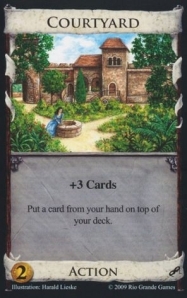
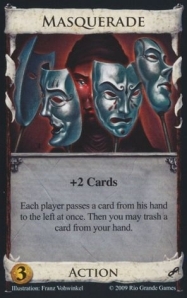
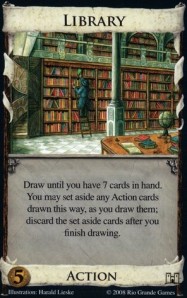

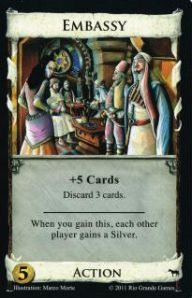



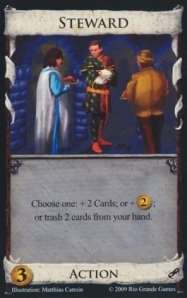







Are you sure you don’t want a Loan in a big money deck? I think it’s fine, especially with Smithy or Envoy.
I’m pretty sure.
Yeah. Adding Silvers is more important than removing Coppers.
Why is there a difference in what to open with between Rabble and Torturer/Margrave? It seems to me that there wouldn’t be a different effect on your own deck and that you’d even want to be more strict with Rabble than with Torturer/Margrave. If you have two terminals in hand, your opponent’s Margrave/Torturer will allow you to solve the collision. But if you have more action cards in a Rabble deck, you’ll see more of them getting discarded by your opponent’s Rabble.
The thing with Rabble is that it can drag the game out a little longer than the other 2, which tend to just try to slow down the early game, but do much less late game. With Rabble, you have the ability to try to build up a little robustness in your deck. Maybe open Bishop so you have points and don’t have to buy Duchies as soon or open Trader to flood in some Silvers.
I don’t see the picture of Embassy and Oracle…
Fixed.
‘In terms of choosing an opening action for Torturer or Margrave, your standards should be about the same as for Embassy, but with Rabble, you can be much more liberal’ Why?
I just had a *very* fast game where the primary cards were Wharf and Golem. (There was one Margrave each, but it never really seemed to matter).
Golem seems like a fantastic enabler for money+draw strats, if you can find time to buy it. Bought my potion somewhere around shuffle 4, then picked up Golems when I could.
One card for a double-wharf hand seemed very strong. Should I have ignored it?
Can’t say exactly without knowing the board, but in general it is too slow to buy a potion, buy the golem, use the golem, as opposed to the other stuff you could be doing.
There were alchemists and philosophers stones, some stuff I can’t remember, wharf, Montebank (not margrave) and Golem. No other 5s. I may have picked up the potion with a spare buy. Not a logged game (I don’t play signed in).
It seemed like it gave me a lot of accelleration (Getting Monetbank+Wharf or double Wharf turns let me double-province and province+gold), but I wouldn’t be suprised if it actually slowed me down.
Well, the Mountebank changes things as the curses and coppers will slow the game down considerably and make the Golems more potent.
You should still have stats at councilroom.com even without registering. I know I do.
(forgot to put my name in)
I think it’s worth expanding a little more on the differences between Margrave, Rabble, and Torturer- specifically, that Margrave plays far differently than Torturer/Rabble, and you’re generally quite happy to just go BM-Margrave, oftentimes even when Villages are around, whereas the other two really prefer to be in an engine and are really no better than than Smithy-BM (given the $4/$5 gap) in the absence of Village. This is because Torturer and Rabble’s attacks get progressively more painful when stacked, but each subsequent play of Margrave softens the blow-three cards hands are not that great, but if you have seven or eight or nine cards to choose from, the attack can even help you. So even though Margrave has the +Buy, which is normally a good reason to go engine, it prefers to be just played once – so BM, unless you have other +Cards as well. Torturer is of course the other extreme, if it can only hit at most once, it’s not even as painful as Militia, so it strongly prefers engines even in the absence of +Buy. Rabble stacks in a way that strongly prefers engines, but the attack is sufficiently weaker that you really want +Buy too, and might be okay with just Rabble-BM in the absence of that. It falls in the middle.
Good point about Margrave. I guess you really need much more help to build a Margrave engine than a Torturer or Rabble engine.
Why is island such a good card in the early game? No doubt the 2VP are nice (plus the one from the estate if you otherwise would have trashed it) but isn’t it a pretty slow card given that it takes one turn’s buy to purchase it and another turn’s action to use it?
Journeyman?